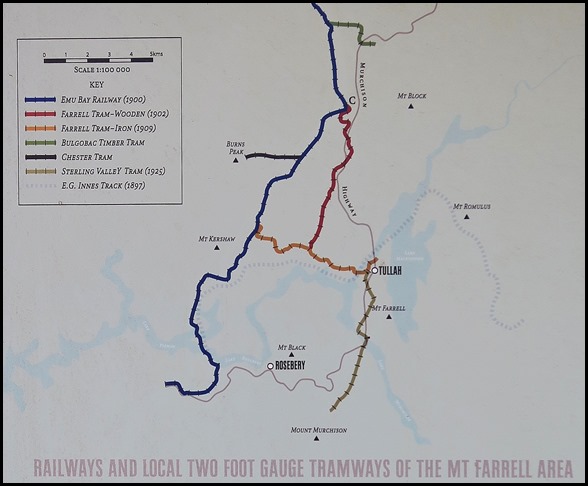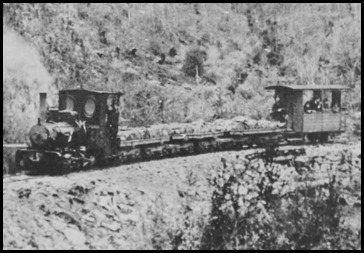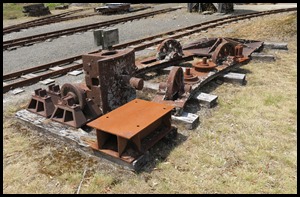Georgie Wood

Beez Neez now Chy Whella
Big Bear and Pepe Millard
Tue 26 Jan 2016 23:27
|
Wee Georgie
Wood
 We pulled off the main road as the words ‘Steam Railway’ came into view. I hoped little
Wee Georgie Wood was fired up and I could get Bear aboard, sadly, he was in his
shed but we still had a good look around. These hills are made of silver. Mount
Farrell was originally prospected in 1894 by Thomas Farrell, the son of an Irish
hotelier. In 1897, while forging a pack track through the area, Edward George
Innes and his party discovered galena, the most important ore in silver mining.
Soon after the Mount Farrell Mine was established, followed by many other mines,
creating the town of Tullah.
Early communication into Mount
Farrell Mining Field was via the Innes Track. By 1902 a horse drawn tram was
established and ran from Boco Siding from the north but by 1909 steam locomotion
had replaced the horses and a new and closer Farrell Siding was established
downstream on the northern banks of the Pieman River. From 1909 to 1964 a
succession of small two-foot gauge locomotives plied the line from Farrell
Siding to Tullah township providing all the necessities of life. Included in
those locomotives was the famed Wee Georgie Wood, a steam locomotive which still
operates today.
Hydro-electric developments resulted
in the Murchison Highway being constructed, with the last mine closing down in
the early 1970’s. The Hydro Electric Commission had built a new town to house
their large workforce for the net twenty years. The two towns survive from both
eras and are united as one town to this day.
Tullah today enjoys an ideal
lifestyle with mild summers averaging in the mid twenties and cool wet winters
with an average rainfall of 2400 mm – ideal for the adventurous outdoors person
wishing to fish the lakes or walk the many tracks to witness the spectacular
lake and mountain views in the area.
  Circa 1899, a prospector walking over
the Innes Track from Mount Farrell to Rosebery and
today still used as part of the Overland
Track.
 Surrounding us are the majestic
mountains rich in mining history. The south horizon is dominated by Mount
Murchison, which at a height of 1275 metres is the largest mountain at the
northern end of the West Coast Range. Mount Murchison
[seen on the skyline behind the War Memorial], was first sighted in 1828 by
explorer Henry Hellyer, and later named by Charles Gould who had been given the
task by the eminent statesman and geologist Sir Roderick Murchison to explore of
the west of Tasmania for mineral wealth.
To the east, obscures by trees from
our vantage point, is Mount Farrell, a long craggy mountain raising at its
summit to 712 metres. It was also sighted by Henry Hellyer in 1828, but not
named until 1894 when geologist Alexander Montgomery named the mountain in
honour of the prospector Thomas Farrell.
To the west is Mount Sale, a smooth
topped mountain at a height of 521 metres. Mount Sale was named after William
Robur Sale, who was in charge of constructing the northern section of the West
Coast Railway link to the Pieman River Crossing. The railway workmen bestowed
the honour on Mr. Sale, who later became mine manager at the Mount Farrell Mine
and lived in the town for many years.
 The first mining boom in the region was in 1871 at Mount Bischoff near Waratah. This
was followed by a rush at Mount Heemskirk, south of Corinna and another at
Zeehan, which in the 1890’s became the third largest town in Tasmania. Many
other rushes followed: some became successful mines, a few such as those at
Queenstown and Rosebery were still in operation a century later. Today new
mineral discoveries continue to be made, most of the mines and towns have
disappeared back into the forest.
 After the Innes Brothers discovered
galena and began mining, the major impediment for the success of the early mine
was the distance from the only access to the outside world, the Emu Bay Railway.
The Emu Bay Railway was only eight miles away, but the cost of freight was
exorbitant at two pounds and five shillings a ton. Pack horses, laden with
hessian bags of heavy concentrate were not only expensive – they were slow. In
the wet climate, tracks quickly became seas of mud. In 1902 Dunkerly Bros. from
Zeehan were contracted to build a horse-drawn wooden tramway. Freight dropped to
five shillings a ton. This was a temporary fix however, for the nine working
mines in the area were together producing much more than what could be packed
out to the siding at Boco.
  In 1909 the North Mt Farrell Mining
Co. the largest and most successful of the mines, built a six-mile-two-foot
gauge iron railway to run a steam locomotive and rolling stock. The first
locomotive was a small Krauss, at that time a type
widely used on the West Coast. This was followed by another second hand
locomotive acquired from the Magnet mine near Waratah.
In 1924 the town took delivery of a
new, purpose built locomotive, the ‘Wee Georgie
Wood’. For the locals this train was never an ‘it’, but was always
referred to ‘he’. For forty years ‘he’ made an estimated 20,000 return trips
travelling some 240,000 miles. ‘His’ outward freight was an average six tons of
concentrate. ‘His’ inward freight was anything and everything.
At the end of 1964 Wee Georgie Wood was retired when the mill closed and ore
transported by road to Rosebery. In 1977 the Wee Georgie Wood Steam Railway was
formed, the locomotive was restored and in 1987 began providing short trips for
visitors.
  When the new locomotive arrived all
the way from the manufacturers in Leeds, Tullah residents were bemused to see on
each side of the midget locomotive a brass plate
inscribed ‘Wee Georgie Wood’. Wee Georgie was
in fact a British actor and comedian who appeared in films, plays and music hall
revues, seen above with Laurel and Hardy. Wood when fully grown was only four
foot nine inches, started music hall career at the age of five. He continued
performing for over fifty years and was considered to have been one of the most
successful pantomime stars of his era.
 Tullah’s one link with the outside
world. With only one way in and one way out for residents, visitors and any
company or government officials, a bush telegraph warning system evolved. When
approaching Tullah side of the Pieman River bridge, a single short whistle meant
‘coming in, everything normal’. If a questioning wail was added to
this, locals knew that there was a stranger on board, ‘business
unknown’. Two urgent blasts repeated halfway up the hill into the town was
advance warning for the school teacher or the mine manager as the signal
translated ‘Inspectors on board, duck for cover’. Finally, three urgent
whistles in quick succession, repeated halfway up the hill, meant ‘Police on
board’......Needless to say there was very little petty crime ever
detected........
  Wee Mary
joined the line in 1928. In 1946 both locomotives
were due for overhaul and a single composite locomotive was built from parts of
the two. This retained the name Wee Georgie Wood. No 2
Passenger Car was built in about 1920 by the Mt Lyell Mining and Railway
Company using early 1900’s bogies from ore cars and used on the Mt Lyell
two-foot gauge system until about 1965. This car is on loan from the collections
of the West Coast Heritage Centre Zeehan.
   The little
station, Wee Georgie’s flyer and bits and bobs.
   Bimbling about the site, Bear found a
‘trigger finger’ point. The water
tower. A once carefully owned
chap.
   More views.
 Wee Georgie
Wood in his hutch.
ALL IN ALL SHAME WE DIDN’T
GET A RIDE
QUITE A FIND IN THE MIDDLE OF
NOWHERE |